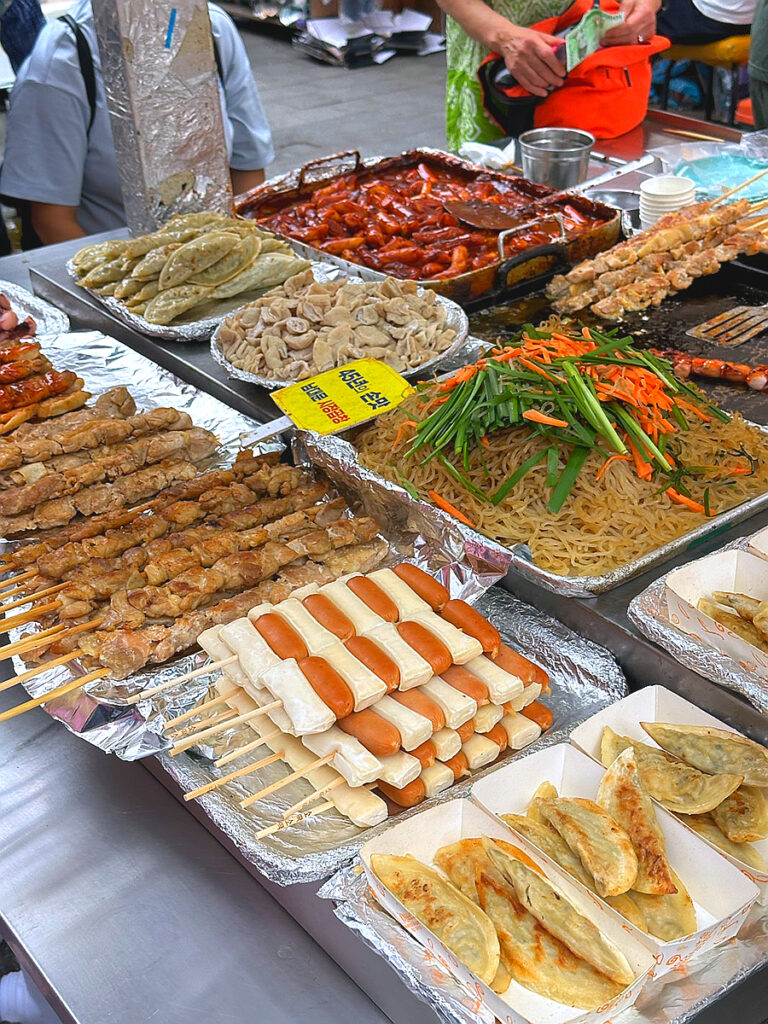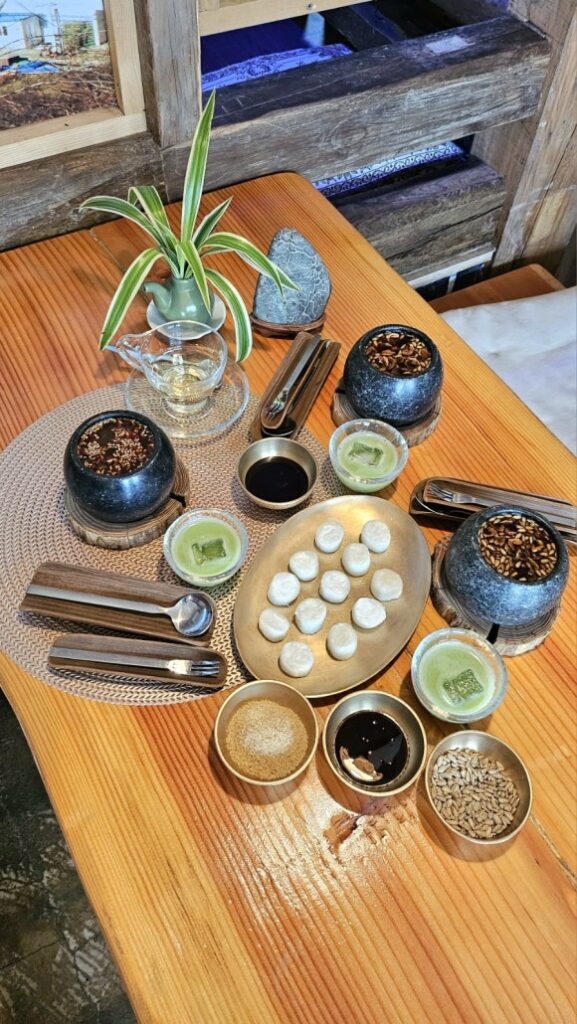Local Food And Drink
Hey foodies!
If you’re visiting Korea, you absolutely need to explore the vibrant world of local food and drinks.
From bustling markets to traditional dishes, here’s your ultimate guide to must-visit spots for authentic Korean culinary experiences.
Let’s break it down by categories!
Traditional Markets For Local Food
– Gwangjang Market –

- Why Visit:
Gwangjang Market is one of South Korea’s oldest and largest traditional markets, offering a vibrant mix of history, culture, and authentic Korean street food. It’s a must-visit for foodies and those seeking an immersive local experience. - Must-Try:
- Bindaetteok (Mung Bean Pancakes): The market’s signature dish.
- Mayak Gimbap: Bite-sized seaweed rice rolls with addictive flavors.
- Tteokbokki: Spicy rice cakes with fish cakes.
- Knife-Cut Noodles (Kalguksu): A hearty, handmade noodle soup.
- Description:
Established in 1905, Gwangjang Market was Korea’s first permanent market and remains a bustling hub of over 1,500 vendors. It offers everything from textiles to souvenirs but is best known for its lively food stalls serving traditional dishes. - Highlights:
- Authentic Korean street food featured in Netflix’s Street Food: Asia.
- A mix of locals and tourists enjoying the vibrant atmosphere.
- Accessible location near Jongno 5-ga Station.
- Tip:
Visit early or late afternoon on weekdays to avoid peak crowds. Bring cash, as many stalls don’t accept cards!
– Namdaemun Market –

- Why Visit:
Namdaemun Market is South Korea’s oldest and largest traditional market, dating back to 1414. It offers a vibrant shopping experience, rich history, and a chance to explore authentic Korean culture. - Must-Try:
- Shop for affordable goods like clothing, accessories, and souvenirs.
- Try street foods such as hotteok (sweet pancakes) and mandu (dumplings).
- Visit the market at night for its bustling wholesale scene.
- Description:
Located near Namdaemun (Sungnyemun Gate), this sprawling market has over 10,000 shops selling everything from household items to traditional medicine. It’s a lively hub for locals and tourists alike. - Highlights:
- 24/7 operation with vibrant day and night markets.
- Affordable prices with direct-from-manufacturer goods.
- Historical charm as a market dating back to the Joseon Dynasty.
- Tip:
Bring cash for better deals, and visit early morning or late at night to experience the wholesale atmosphere!
– Tongin Market –

- Why Visit:
Tongin Market is a charming traditional market near Gyeongbokgung Palace, offering a unique mix of history, culture, and delicious Korean street food. It’s famous for its Dosirak (lunchbox) experience, where visitors can create their own meal using traditional brass coins. - Must-Try:
- Dosirak Cafe: Use Yeopjeon coins to sample various dishes like tteokbokki, gimbap, and fried seaweed chips.
- Banchan stalls: Explore a variety of Korean side dishes.
- Chicken skewers and crispy snacks: Popular street food options.
- Description:
Established in 1941, Tongin Market has evolved from a local market during the Japanese colonial era into a vibrant cultural spot. With around 75 vendors, it offers fresh produce, traditional dishes, and a glimpse into Seoul’s culinary heritage. - Highlights:
- The interactive Dosirak Cafe experience.
- Compact and easy-to-navigate layout with diverse food options.
- Proximity to Gyeongbokgung Palace and Seochon Village for a full-day itinerary.
- Tip:
Visit between 11 AM and 4 PM for the Dosirak Cafe experience (coins sold until 3 PM). Bring cash for easier transactions and take your time to explore hidden food gems!
Street Food Hotspots
– Myeongdong Street Food Alley –

- Why Visit:
Myeongdong Street Food Alley is a vibrant hotspot in Seoul, offering a mix of delicious Korean street food and a lively shopping atmosphere. It’s perfect for foodies and travelers looking to experience authentic Korean flavors. - Must-Try:
- Tteokbokki: Sweet and spicy rice cakes.
- Grilled Cheese Lobster: A luxurious street food treat.
- Hotteok: Sweet pancakes with fillings like brown sugar or nuts.
- Tornado Potato: Spiral-cut potato on a stick.
- Mayak Corn: Addictive buttered corn with secret spices.
- Description:
Located in the heart of Myeongdong, the alley is lined with over 200 food vendors offering everything from traditional Korean dishes to fusion snacks. It’s a pedestrian-friendly zone that comes alive in the evening with bright lights and bustling crowds. - Highlights:
- Unique street foods like grilled abalone and croissant bungeoppang.
- Affordable snacks perfect for sampling a variety of flavors.
- Proximity to Myeongdong Station (Line 4) for easy access.
- Tip:
Visit after 5 PM when most stalls open, and bring cash for faster transactions. Be prepared for crowds, especially on weekends!
Traditional Tea Houses
– Insadong Tea Houses –

- Why Visit:
Insadong is Seoul’s cultural heart, known for its traditional Korean charm, art galleries, antique shops, and tea houses. It’s the perfect destination to experience Korea’s heritage while enjoying a lively and unique atmosphere. - Must-Try:
- Stroll along Insadong-gil Street for galleries, crafts, and souvenirs.
- Visit Ssamziegil, a spiral shopping complex with handmade goods.
- Enjoy traditional teas at cozy hanok-style tea houses.
- Explore nearby Jogyesa Temple, just a short walk away.
- Description:
Insadong is a vibrant neighborhood with a mix of historic and modern attractions. Its main street and maze-like alleys are filled with antique stores, calligraphy workshops, and cultural experiences. Every weekend, the area becomes pedestrian-only, hosting street performances and markets. - Highlights:
- Over 100 art galleries showcasing traditional and contemporary works.
- Unique shops selling antiques, pottery, and handmade crafts.
- Cultural events like calligraphy classes and street performances.
- Tip:
Visit on weekends for the pedestrian-friendly market and cultural activities. Don’t miss Ssamziegil’s rooftop garden for great views of the area!
※ Remember
- Bring cash! Many street vendors don’t accept cards.
- Be adventurous – try something new like sundae (blood sausage) or beondegi (silkworm pupae)!
- Check market hours – some close early or are closed on Sundays.
Whether you’re a foodie looking to indulge in Korean street food lover hunting for the best tteokbokki, these spots will leave you craving more.
Happy eating!
© 2025 All Rights Reserved.
